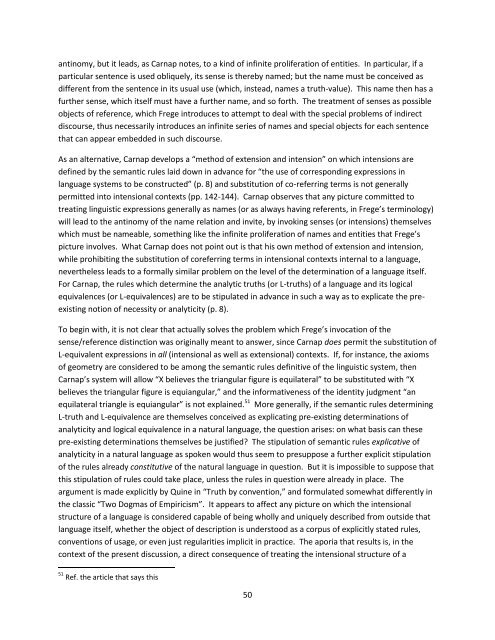Heidegger, Tugendhat, Davidson - University of New Mexico
Heidegger, Tugendhat, Davidson - University of New Mexico
Heidegger, Tugendhat, Davidson - University of New Mexico
Create successful ePaper yourself
Turn your PDF publications into a flip-book with our unique Google optimized e-Paper software.
antinomy, but it leads, as Carnap notes, to a kind <strong>of</strong> infinite proliferation <strong>of</strong> entities. In particular, if a<br />
particular sentence is used obliquely, its sense is thereby named; but the name must be conceived as<br />
different from the sentence in its usual use (which, instead, names a truth-value). This name then has a<br />
further sense, which itself must have a further name, and so forth. The treatment <strong>of</strong> senses as possible<br />
objects <strong>of</strong> reference, which Frege introduces to attempt to deal with the special problems <strong>of</strong> indirect<br />
discourse, thus necessarily introduces an infinite series <strong>of</strong> names and special objects for each sentence<br />
that can appear embedded in such discourse.<br />
As an alternative, Carnap develops a “method <strong>of</strong> extension and intension” on which intensions are<br />
defined by the semantic rules laid down in advance for “the use <strong>of</strong> corresponding expressions in<br />
language systems to be constructed” (p. 8) and substitution <strong>of</strong> co-referring terms is not generally<br />
permitted into intensional contexts (pp. 142-144). Carnap observes that any picture committed to<br />
treating linguistic expressions generally as names (or as always having referents, in Frege’s terminology)<br />
will lead to the antinomy <strong>of</strong> the name relation and invite, by invoking senses (or intensions) themselves<br />
which must be nameable, something like the infinite proliferation <strong>of</strong> names and entities that Frege’s<br />
picture involves. What Carnap does not point out is that his own method <strong>of</strong> extension and intension,<br />
while prohibiting the substitution <strong>of</strong> coreferring terms in intensional contexts internal to a language,<br />
nevertheless leads to a formally similar problem on the level <strong>of</strong> the determination <strong>of</strong> a language itself.<br />
For Carnap, the rules which determine the analytic truths (or L-truths) <strong>of</strong> a language and its logical<br />
equivalences (or L-equivalences) are to be stipulated in advance in such a way as to explicate the preexisting<br />
notion <strong>of</strong> necessity or analyticity (p. 8).<br />
To begin with, it is not clear that actually solves the problem which Frege’s invocation <strong>of</strong> the<br />
sense/reference distinction was originally meant to answer, since Carnap does permit the substitution <strong>of</strong><br />
L-equivalent expressions in all (intensional as well as extensional) contexts. If, for instance, the axioms<br />
<strong>of</strong> geometry are considered to be among the semantic rules definitive <strong>of</strong> the linguistic system, then<br />
Carnap’s system will allow “X believes the triangular figure is equilateral” to be substituted with “X<br />
believes the triangular figure is equiangular,” and the informativeness <strong>of</strong> the identity judgment “an<br />
equilateral triangle is equiangular” is not explained. 51 More generally, if the semantic rules determining<br />
L-truth and L-equivalence are themselves conceived as explicating pre-existing determinations <strong>of</strong><br />
analyticity and logical equivalence in a natural language, the question arises: on what basis can these<br />
pre-existing determinations themselves be justified? The stipulation <strong>of</strong> semantic rules explicative <strong>of</strong><br />
analyticity in a natural language as spoken would thus seem to presuppose a further explicit stipulation<br />
<strong>of</strong> the rules already constitutive <strong>of</strong> the natural language in question. But it is impossible to suppose that<br />
this stipulation <strong>of</strong> rules could take place, unless the rules in question were already in place. The<br />
argument is made explicitly by Quine in “Truth by convention,” and formulated somewhat differently in<br />
the classic “Two Dogmas <strong>of</strong> Empiricism”. It appears to affect any picture on which the intensional<br />
structure <strong>of</strong> a language is considered capable <strong>of</strong> being wholly and uniquely described from outside that<br />
language itself, whether the object <strong>of</strong> description is understood as a corpus <strong>of</strong> explicitly stated rules,<br />
conventions <strong>of</strong> usage, or even just regularities implicit in practice. The aporia that results is, in the<br />
context <strong>of</strong> the present discussion, a direct consequence <strong>of</strong> treating the intensional structure <strong>of</strong> a<br />
51 Ref. the article that says this<br />
50
















